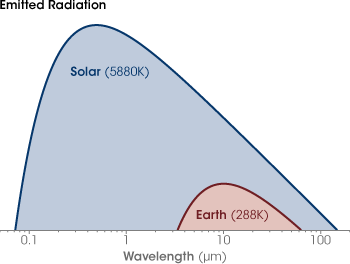

 | |||
When Seiji Kato tells people that he studies the atmosphere and the climate for a living, the usual response, he says, is “Oh! So tell me about hurricanes!” On that subject, however, Kato would have little to tell them. It’s not hard to imagine their response would be at least a little less enthusiastic when he tells them what he really does. At first, “I use satellite data to study the flux of photons at the top of the atmosphere,” just doesn’t seem as exciting as say, predicting whether global warming is making hurricanes stronger. That’s an unfair situation, really, because although it might not seem as exciting, Kato’s photon-flux job is just as important. |
(Title photograph © 2007 Lalallallala.) | ||
 | |||
After all, Earth’s climate, in particular its average temperature, is all about photons. All day, every day the Sun hurls a steady stream of photons toward the Earth in the form of high-energy, shortwave radiation. Some photons are reflected by atmospheric particles, clouds, snow and ice, even ocean whitecaps. Other photons are absorbed by the Earth’s land and ocean surfaces, which heat up. These heated surfaces emit photons back to the atmosphere in the form of lower-energy, long-wavelength radiation. Some of these photons eventually make it all the way back out to space. The balance of incoming and outgoing photons over the whole planet, the net radiative flux, determines Earth’s temperature “set point.” The ability of greenhouse gases to absorb and emit photons is what global warming is all about. |
At an altitude of about 100 kilometers, the Earth’s atmosphere becomes so thin that it essentially ceases to exist. The balance between incoming energy (mostly visible light) and outgoing energy (invisible, thermal radiation) at the ‘top of the atmosphere’ determines the Earth’s average temperature. (Astronaut photograph ISS013-E-54329 courtesy NASA JSC Gateway to Astronaut Photography of Earth.) | ||
 |

So while it might not seem glamorous, keeping tabs on the atmosphere’s radiative flux and all the factors that influence it is crucial to understanding present and future climate. As increasing amounts of greenhouse gases tip the average global temperature toward a warmer “set point,” other parts of the Earth system—like clouds, ice, and snow—change as well. Lately, Kato, an atmospheric scientist affiliated with NASA’s Langley Research Center through Hampton University, has become interested in how those ‘other things’ feed back into the climate system by changing how much radiation the Earth absorbs or emits. About two years ago, Kato began investigating whether, as climate scientists have long anticipated, the retreat of highly reflective snow and ice in the Arctic has already produced a measurable drop in the amount of sunlight the region reflects. |
All objects radiate energy based on their temperature. Because it is much hotter than the Earth, the Sun (surface temperature of 5,880 Kelvin, or more than 10,000 degrees Fahrenheit) radiates more short-wavelength energy. Solar radiation (blue-shaded area) includes a large amount of energy with wavelengths less than 1 micrometer (a millionth of a meter), including visible light. The Sun warms the Earth, and the Earth radiates energy in response. But because the Earth’s average global surface temperature is only about 288 Kelvin (about 59 degrees Fahrenheit), the energy it radiates (red-shaded area) has a longer wavelength than solar radiation. (Graph by Robert Simmon.) | |